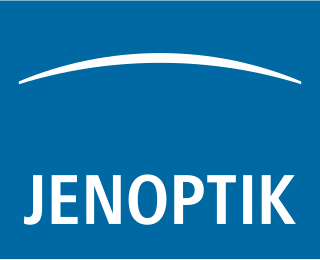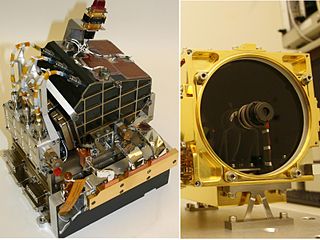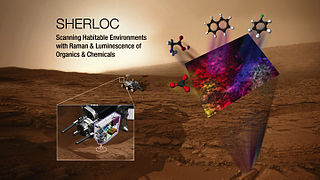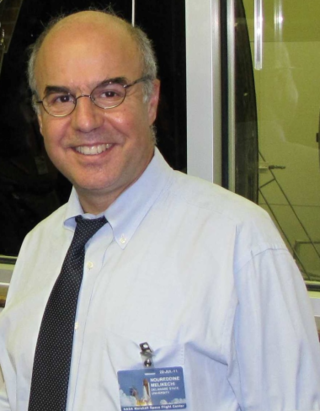
Photonics is a branch of optics that involves the application of generation, detection, and manipulation of light in form of photons through emission, transmission, modulation, signal processing, switching, amplification, and sensing. Photonics is closely related to quantum electronics, where quantum electronics deals with the theoretical part of it while photonics deal with its engineering applications. Though covering all light's technical applications over the whole spectrum, most photonic applications are in the range of visible and near-infrared light. The term photonics developed as an outgrowth of the first practical semiconductor light emitters invented in the early 1960s and optical fibers developed in the 1970s.
Optica is a professional society of individuals and companies with an interest in optics and photonics. It publishes journals and organizes conferences and exhibitions. It currently has about 488,000 customers in 183 countries, including nearly 300 companies.

Mars Science Laboratory (MSL) is a robotic space probe mission to Mars launched by NASA on November 26, 2011, which successfully landed Curiosity, a Mars rover, in Gale Crater on August 6, 2012. The overall objectives include investigating Mars' habitability, studying its climate and geology, and collecting data for a human mission to Mars. The rover carries a variety of scientific instruments designed by an international team.

Jenoptik AG is a Jena, Germany-based integrated photonics company. The company is listed on the Frankfurt Stock Exchange and is included in the TecDAX stock index.

Digital planar holography (DPH) is a method for designing and fabricating miniature components for integrated optics. It was invented by Vladimir Yankov and first published in 2003. The essence of the DPH technology is embedding computer designed digital holograms inside a planar waveguide. Light propagates through the plane of the hologram instead of perpendicularly, allowing for a long interaction path. Benefits of a long interaction path have long been used by volume or thick holograms. Planar configuration of the hologram provider for easier access to the embedded diagram aiding in its manufacture.
Pittcon Editors’ Awards honoured the best new products on show at the Pittsburgh Conference on Analytical Chemistry and Applied Spectroscopy, or Pittcon, for 20 years from 1996 having been established by Dr Gordon Wilkinson, managing editor of Analytical Instrument Industry Report. On 8 March 2015, the event returned to the Morial Convention Center in New Orleans and this was the last occasion when the awards were presented.
Robert Alfano is an Italian-American experimental physicist. He is a Distinguished Professor of Science and Engineering at the City College and Graduate School of New York of the City University of New York, where he is also the founding director of the Institute for Ultrafast Spectroscopy and Lasers (1982). He is a pioneer in the fields of Biomedical Imaging and Spectroscopy, Ultrafast lasers and optics, tunable lasers, semiconductor materials and devices, optical materials, biophysics, nonlinear optics and photonics; he has also worked extensively in nanotechnology and coherent backscattering. His discovery of the white-light supercontinuum laser is at the root of optical coherence tomography, which is breaking barriers in ophthalmology, cardiology, and oral cancer detection among other applications. He initiated the field known now as Optical Biopsy

The composition of Mars covers the branch of the geology of Mars that describes the make-up of the planet Mars.
Rosalind Franklin, previously known as the ExoMars rover, is a planned robotic Mars rover, part of the international ExoMars programme led by the European Space Agency and the Russian Roscosmos State Corporation. The mission was scheduled to launch in July 2020, but was postponed to 2022. The 2022 Russian invasion of Ukraine has caused an indefinite delay of the programme, as the member states of the ESA voted to suspend the joint mission with Russia; in July 2022, ESA terminated its cooperation on the project with Russia. As of May 2022, the launch of the rover is not expected to occur before 2028 due to the need for a new non-Russian landing platform.

Sample Analysis at Mars (SAM) is a suite of instruments on the Mars Science Laboratory Curiosity rover. The SAM instrument suite will analyze organics and gases from both atmospheric and solid samples. It was developed by the NASA Goddard Space Flight Center, the Laboratoire des Atmosphères Milieux Observations Spatiales (LATMOS) associated to the Laboratoire Inter-Universitaire des Systèmes Atmosphériques (LISA), and Honeybee Robotics, along with many additional external partners.

Curiosity is a car-sized Mars rover exploring Gale crater and Mount Sharp on Mars as part of NASA's Mars Science Laboratory (MSL) mission. Curiosity was launched from Cape Canaveral (CCAFS) on November 26, 2011, at 15:02:00 UTC and landed on Aeolis Palus inside Gale crater on Mars on August 6, 2012, 05:17:57 UTC. The Bradbury Landing site was less than 2.4 km (1.5 mi) from the center of the rover's touchdown target after a 560 million km (350 million mi) journey.

N165 is a rock on the surface of Aeolis Palus in Gale Crater on the planet Mars near the landing site of the Curiosity rover. The "approximate" site coordinates are: 4.59°S 137.44°E. On August 19, 2012, the rock was the first target of the rover's laser instrument, ChemCam, which can analyze targets at a distance using a laser and spectrometer. A Twitter feed for the rock was created, featuring an anthropomorphized account of its experiences. Its posts include a humor themed mix of social interaction and Mars content such as "Did you know I was born in a volcano? Basalts like me come from lava. That's why we call it Olympus Mom".

Chemistry and Camera complex (ChemCam) is a suite of remote sensing instruments on Mars for the Curiosity rover. As the name implies, ChemCam is actually two different instruments combined as one: a laser-induced breakdown spectroscopy (LIBS) and a Remote Micro Imager (RMI) telescope. The purpose of the LIBS instrument is to provide elemental compositions of rock and soil, while the RMI will give ChemCam scientists high-resolution images of the sampling areas of the rocks and soil that LIBS targets. The LIBS instrument can target a rock or soil sample from up to 7 m (23 ft) away, vaporizing a small amount of it with about 30 5-nanosecond pulses from a 1067 nm infrared laser and then observing the spectrum of the light emitted by the vaporized rock.

Scanning Habitable Environments with Raman and Luminescence for Organics and Chemicals (SHERLOC) is an ultraviolet Raman spectrometer that uses fine-scale imaging and an ultraviolet (UV) laser to determine fine-scale mineralogy, and detect organic compounds designed for the Perseverance rover as part of the Mars 2020 mission. It was constructed at the Jet Propulsion Laboratory with major subsystems being delivered from Malin Space Science Systems and Los Alamos National Laboratory. The Principal Investigator is Luther Beegle, and the Deputy Principal Investigator is Rohit Bhartia.

Lightwave Electronics Corporation was a developer and manufacturer of diode-pumped solid-state lasers, and was a significant contributor to the creation and maturation of this technology. Lightwave Electronics was a technology-focused company, with diverse markets, including science and micromachining. Inventors employed by Lightwave Electronics received 51 US patents, and Lightwave Electronics products were referenced by non-affiliated inventors in 91 US patents.

Noureddine Melikechi is an Algerian atomic, molecular, and optical physicist, educator and inventor. He is the author of more than 125 peer-reviewed publications, three book chapters and 15 patents. Melikechi is a member of the Mars Science Laboratory, NASA’s largest Mars exploration effort to date.

SuperCam is a suite of remote-sensing instruments for the Mars 2020 Perseverance rover mission that performs remote analyses of rocks and soils with a camera, two lasers and four spectrometers to seek organic compounds that could hold biosignatures of past microbial life on Mars, if it ever existed there.
Raman Laser Spectrometer (RLS) is a miniature Raman spectrometer that is part of the science payload on board the European Space Agency'sRosalind Franklin rover, tasked to search for biosignatures and biomarkers on Mars. The rover is planned to be launched in August–October 2022 and land on Mars in spring 2023.

Alpes Lasers S.A. is a Swiss engineering company and manufacturer of Infrared lasers and electrical drivers based in St-Blaise, Canton of Neuchâtel. The company was the first to commercialize the quantum-cascade laser (QCL) for scientific, industrial and medical use. The company has also developed QCLs for defensive countermeasure applications for the United States Air Force.

Debabrata Goswami FInstP FRSC, is an Indian chemist and the Prof. S. Sampath Chair Professor of Chemistry, at the Indian Institute of Technology Kanpur. He is also a professor of The Department of Chemistry and The Center for Lasers & Photonics at the same Institute. Goswami is an associate editor of the open-access journal Science Advances. He is also an Academic Editor for PLOS One and PeerJ Chemistry. He has contributed to the theory of Quantum Computing as well as nonlinear optical spectroscopy. His work is documented in more than 200 research publications. He is an elected Fellow of the Royal Society of Chemistry, Fellow of the Institute of Physics, the SPIE, and The Optical Society. He is also a Senior Member of the IEEE, has been awarded a Swarnajayanti Fellowship for Chemical Sciences, and has held a Wellcome Trust Senior Research Fellowship. He is the third Indian to be awarded the International Commission for Optics Galileo Galilei Medal for excellence in optics.















